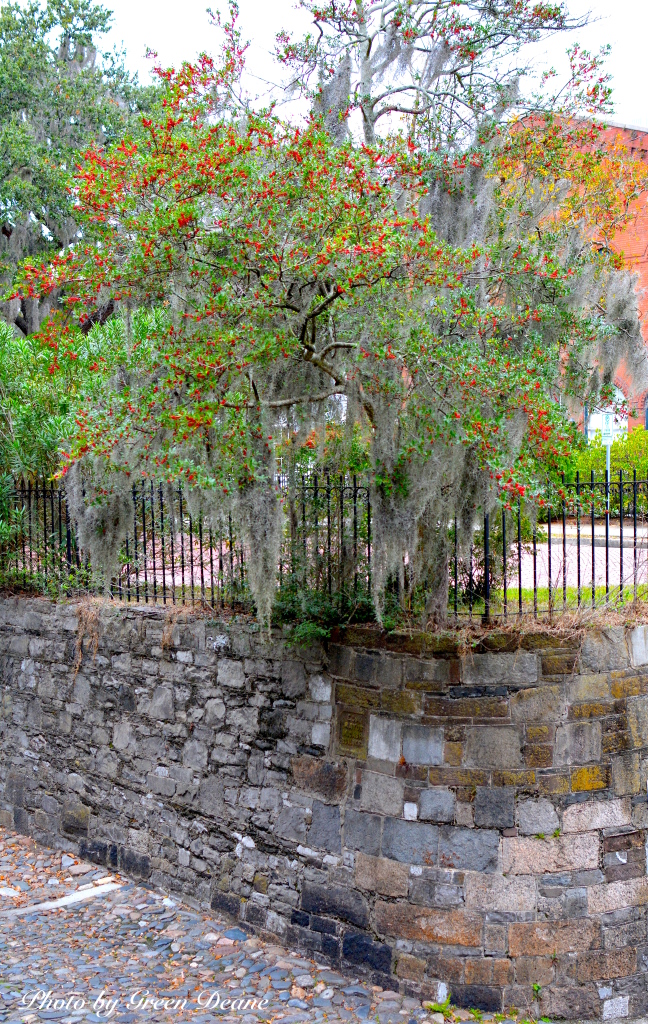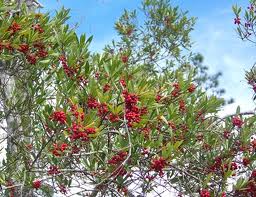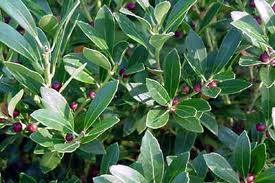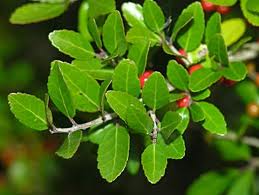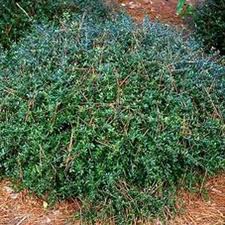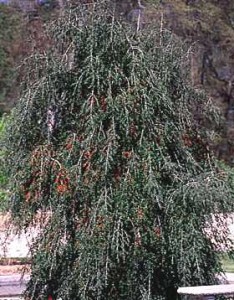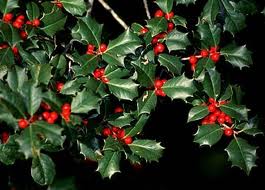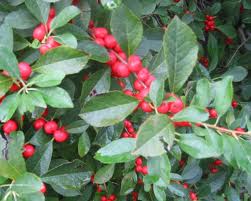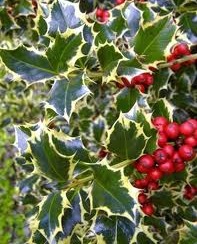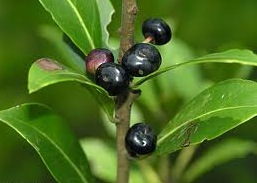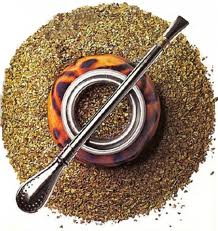Holly Tea With Vitamins A & C
This time of year in the South — late fall, early winter —some of the hollies are so scarlet with berries that even the tourists can spot them while doing 85 on Interstate 95, if they bother to look. The hollies, usually Ilex cassine, resemble red torches beside the roadway. Their brilliant berries are food for woodland creatures. You are not a woodland creature, so leave the berries alone. However, the leaves of some hollies can be carefully made into a tea, with or without caffeine. The leaves also have vitamin A and C and are packed with antioxidants.
The often-preferred holly for decaffeinated tea is the gallberry, Ilex glabra (EYE-lecks GLAY-bruh) which means smooth oak. Why oak? Well, it’s a bit of a linguistic fudging. There is a European oak tree that resembles the holly and it was called … in Dead Latin, Ilex, or the Holly Oak. So when hollies were being named, their leaves were like the holly oak so Ilex became their genus name even though hollies are not oaks. It’s just one of those things one can expect from a dead language only academics like, whereas the older Greek, still spoken, is doing well and is not misnaming plants. Also called the Inkberry — because of its non-edible black berries, and the Bitter Gallberry — dried gallberry leaves taste exactly like orange pekoe tea, except, as mentioned, without the caffeine. But, now a bit of qualification:
The Yaupon Holly, which has the highest caffeine content of any plant in North America, is called Ilex vomitoria (EYE-lecks vom-ih-TOR-ee-uh.) Yeph, it means what you think it mean: vomiting oak but we know it is really vomiting holly… still not pleasant. Native Indians used to make an every-day caffeinated drink from its young leaves and twig tips. However, for solemn ceremonies they would boil up an intentionally strong brew only for the men to drink. The fellow who could hold the concoction down the longest was entrusted with important missions. Osceola means “yapon singer” meaning he could hold the stuff down the longest, which brings me back to gallberry.
To make gallberry tea, just collect some leaves, air dry or dehydrater dry them (that’s important) then roast them in a slow oven until golden, then crush. Pour hot water over them, let them seep for two minutes, and enjoy. Unfortunately, while that tea tastes just like regular tea, and has no caffeine, it does not like me. I seem to be the only one but it is the first plant I’ve run into that causes me problems. If I drink Gallberry tea within 40 minutes I have to go pray to the porcelain god.
Traditionally Yaupon was processed differently. The leaves were kiln dried then powdered in mortars. Some of the powder was put in a bowl and cold water poured over it and allowed to sit a few minutes. Then hot water was added. Some writers say the ceremonial brew was made from green Yaupon that were used fresh, read not allowed to dry. Roasting, however, does increase the availability of the caffeine.
Dr. William A. Morrill. a plant PhD, wrote in 1940 there are two ways to make holly tea. One is to boil the cured leaves like coffee, not seep them like tea. (Cured means oven dried or steamed.) But, of the Yaupon, he said the best holly tea was to use an equal mix of chopped brown dry roasted and steamed green leaves (remember you must dry them first, then roast or steam.) I got his information from a crumbling, out-of-print book. Only you and I know it. While Yaupon Holly tea does have a lot of caffeine it is practically free of tannin, which reduces bitterness considerably. It is also full of antioxidants which are good for you.
The form of I. vomitoria that has the most caffeine is the Weeping Holly or Ilex vomitoria var. “pendula.”Feeding” it nitrogen also increase the amount of caffeine. The ornamental holly, Ilex nana (EYE-lecks NAH-nuh) is a female dwarf version of the I.
vomitoria. Ilex schiller/schilling is a male dwarf version of the Ilex vomitoria. A tea of either made from dried leaves is caffeinated. Of the two, here in the South the dwarf versions is the most commonly encountered. As a landscape plant they are actually much easier to find than the parent Ilex vomitoria., depending on where you live. The Yaupon holly was a very popular drink into the late 1800s. Why it fell from favor is not known though coffee might have had something to do with it. In the 2009 Journal of Economic Botany an article recommended Yaupon become a commercial crop again, especially considering its high levels of antioxidants.
If your dwarf holly has black berries (and is not the Ilex glabra) and grows upright (pencil like) then you have Ilex crenata, a common northern landscape holly. I don’t know if that is consumable. Two other hollies, however, make good tea without caffeine: the American Holly, Ilex opaca ( EYE-lecks oh-PAY-kuh) and Ilex verticillata, (EYE-lecks ver-ti-si-LAH-tuh.)
The American Holly was a popular tea during the American Civil War. Interestingly, the American Holly and the English Holly were used to clean chimneys because of their stiff, toothy leaves. Holly branches and leaves were tied together into a large bundle then attached to the middle of a long rope. The rope was fed down the chimney and the bundle pulled up and down until the chimney was free of soot and other deposits.
The Dahoon Holly is the full-sized tree used most often for landscaping. It’s very leafy and with lots of berries. American Holly is the one found most often in Christmas wreaths with curly, pointy leaves. If the wreath hasn’t been sprayed, you can recycle it in your tea cup. And, while holly tea is fine and dandy — for most, he says with envy — let me remind you: Don’t eat the berries. They are mildly toxic to an adult. Twenty to 30, however, is a lethal dose for a small child. I have seen hollies planted in landscaping around primary schools here in Florida. Now ain’t that brilliant. The Dahoon Holly, Ilex cassine (EYE-lecks kuh-SIGH-nee) makes a tea without caffeine but it is the least recommend of them all. It can cause headaches and can be laxative.
One little aid in identification of all hollies including the gallberry: They will have at least three or more points or “tooths” on the leaves, minute in the gallberry, like tiny, tiny, soft thorns, makes it kind of look like the Boy Scout salute. If you take a very close look at the gallberry picture, you can see the points on the leaves. All hollies have them, sometimes obvious, sometimes very muted and rudimentary, but there none the less. The Dahoon Holly will have toothless leaves and leaves with teeth though those with teeth the teeth are usually on the upper part of the blade.
The English Holly, or European Holly, Ilex aquifolium, (EYE-lecks a-kwee-FOH-lee-um) found in Europe, is a common landscape plant in the United States and is naturalized in Ontario and the pacific coast California to Alaska. You’ll know it when you see it, it looks like the American Holly
except it often has an edging of yellow or white around the leaf. Its leaves have been dried for tea, the roasted berries used as a coffee substitute (doubtful and be cautious) and the berries are also used to make a brandy. Ilex latifolia leaves are made into tea in Asia, the seeds into a coffee. The jury is out on Ilex cornuta (EYE-lecks kor-NOO-tuh.) The Chinese have a lot of herbal applications, the tea is supposedly a contraceptive for women, and whether the berries are edible or not is iffy. I mention it because the Ilex cornuta var Bufordii is a common landscape plant sold at home do-it-yourself stores in Florida. Yerba mate, the most common drink is South America, is made from the Ilex paraguariensis. ( EYE-lecks para-gwar-ee-EN-sis)
One more thing…there is another gallberry holly, called Ilex coriacea EYE-lecks kor-ee-uh-KEE-uh.) It has reddish twigs and the leaves have little spines on them, whereas the gallberry has dimples usually. The I. coriacea grows much larger — a small tree to fifteen feet is possible —and there are some reports the berries are edible, hence the nickname Sweet Gallberry. Gray’s Manual of Botany says the berries are “in an axil, soft and pulpy when ripe, dropping in autumn, said to be edible.” While I have seen the Sweet Gallberry in north Florida near the headwaters of the Santa Fe River it has never had any berries on it for me to try.
Cassine is from an American Indian name for a plant with similar fruit. In early writings both the Dahoon and the Yapon were called Cassine. Opaca means shady because the plant can grow in some shade. Verticillata means in a whorl and coriacea means leathery. Cornuta is bearing horns or spurs, usually the flowers. And aquifolium means …. holly-like leaves… THAT certainly took imagination.
Incidentally, gallberry is considered a quality and consistent source of bee nectar in Florida and is the top third or fourth producer of honey. If a bee can like it, maybe you can, too.
Keying out Ilexes in Florida:
Group One
Leaves thin, membranous
Leaves evergreen, entire or rarely denticulate, fruit dull purplish
to black, plants of south Florida only ….. Ilex krugiana
Leaves deciduous
Leaves pubescent on most of the upper surface, margins serrate
Leaf blades elliptic with a rounded leaf base, 6-9 cm long….. Ilex amelanchier
Leaves smooth on the upper surface, margins crenate to serrate
Leaf blades oblanceolate to ovate, 2-6 cm long, margins crenate ….. Ilex decidua
Leaf blades elliptic to ovate, margins serrate to crenate
Leaves with conspicuous veins, flowers and fruit appear singly or
in clusters up to 3, in the leaf axils….. Ilex verticillata
Leaves without conspicuous veins, flowers and fruit appear
clustered from spur shoots ….. Ilex ambigua
Group Two
Leaves coriaceous, evergreen
Fruit red to yellow, Leaf blade with sharp pointed teeth, these are usually regularly
spaced ….. Ilex opaca
Leaf blade entire, crenate or serrulate, Leaf blades with a rounded apex ….. Ilex vomitoria
Leaf blades with a sharp, pointed apex
Leaf blades 1-4 cm long and usually less than 1.5 cm wide,
margins entire, tip sharp pointed ….. Ilex myrtifolia
Leaf blades generally longer than 4 cm and wider than 2 cm,
may have a few teeth at the tip or with a single sharp
point ….. Ilex cassine
Fruit black
Leaves crenate, leaves often cupped, 3-5 cm long
….. Ilex glabra
Leaves with a few small teeth, leaves somewhat cupped, 4-7 cm long
….. Ilex coriacea

